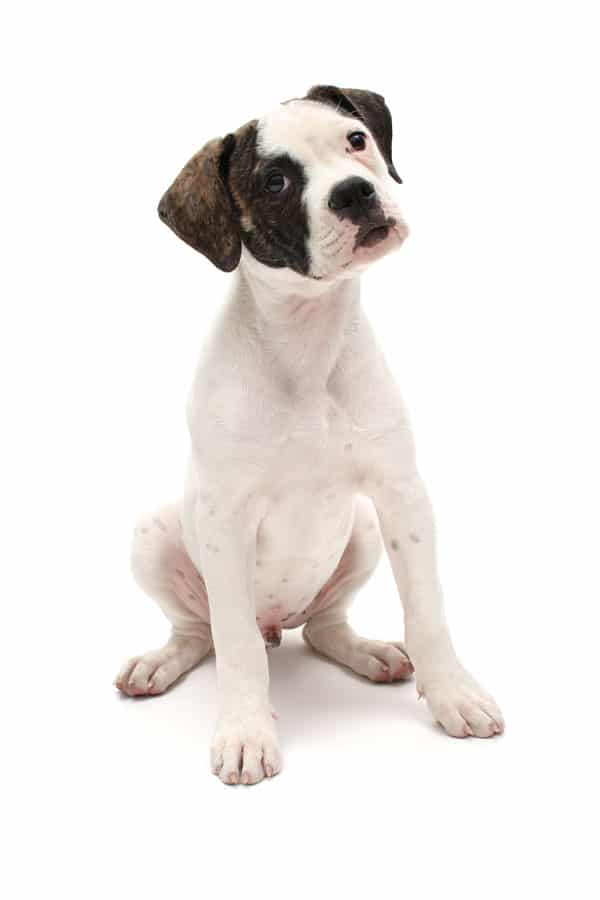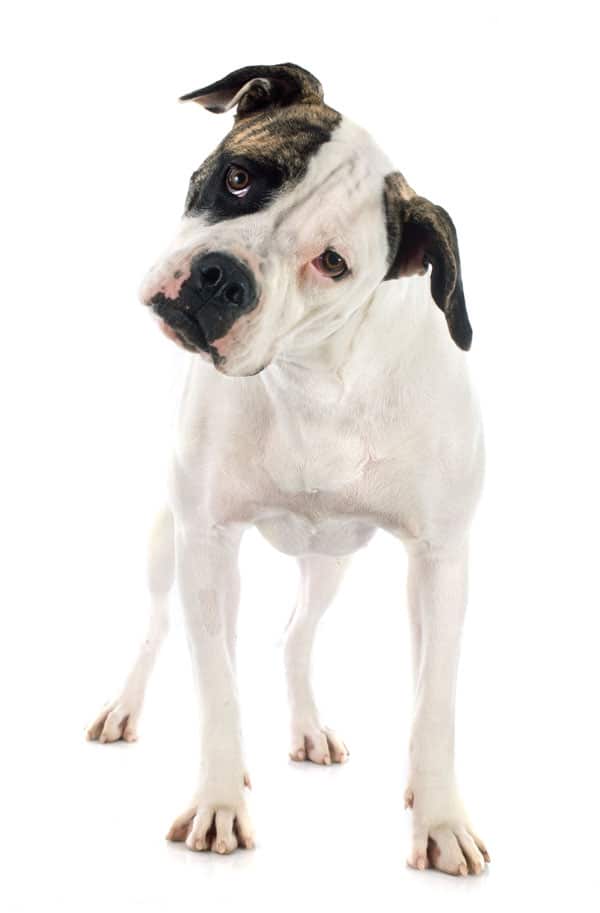Editor’s note: Have you seen the Dogster print magazine in stores? Or in the waiting room of your vet’s office? This article appeared in our February-March issue. Subscribe to Dogster and get the bimonthly magazine delivered to your home.
The sleek and muscular American Bulldog is the white knight of the dog world. Here are some fascinating facts about this versatile canine.
1. The journey to America
The Bulldogs in England started out working cattle and watching over their owners’ property. The breed’s courage and background with livestock led to its use in the blood sport of bull baiting. Eventually, the gruesome pursuit was outlawed, and the Bulldog was bred down to become a shorter, stockier, less athletic animal. However, the original Bulldog had been preserved by working-class immigrants who brought their dogs with them to the American South to fill many jobs on their small farms and ranches.
2. One breed, two looks
By the end of World War II, the American Bulldog was almost extinct in this country. It took John D. Johnson, a returning war veteran, to resurrect the breed. Johnson, along with Alan Scott and several other breeders, began to re-establish the American Bulldog. However, because of the many different jobs the breed was asked to do, several different bloodlines were established, each promoting the physical traits necessary to perform that function. The two best known lines were the Johnson type, with a bulkier body, heavier bone, larger head, and more of a “bully” look; and the Scott type, more athletic and moderate, and better suited to excel in performance events. Today, many American Bulldogs are considered a hybrid of these two original lines.

American Bulldog puppy by Gina Cioli/Lumina Media.
3. Catch dogs
The breed’s primary job has always been to work as a hog- and cattle-catching dog and a protector of personal property. A catch dog is specially trained and used to catch large animals in hunting, working livestock, and baiting. Hunters make a distinction between catch dogs and “bay dogs” that corner prey animals and alert their handler by howling or baying.
4. Socialization is key
Young American Bulldogs may be slightly aloof with strangers, displaying protective instincts. It is essential that they be exposed to friendly people on a regular, ongoing basis to develop their confidence and comfort level with those who mean them no harm. Without consistent socialization, they may remain suspicious of everyone, which is a liability in a dog of such strength and size. Exposure to other animals is equally essential, although many American Bulldogs will never tolerate another dog of the same sex.
5. A liberal breed standard
Unlike many breed standards that describe a dog of very specific proportions and characteristics, the American Bulldog standard is rather lenient in many areas, allowing the ears to hang naturally, stand semi-erect or be cropped; the tail to be docked or left naturally long; eyes of any color permitted, although dark brown is preferred. These ranges reflect the emphasis that has always been placed on function over aesthetics.
6. Does size matter?
Not so much. American Bulldogs are expected to be agile and powerful enough to chase, catch, and bring down livestock, but their working heritage has never dictated a rigid height and weight. Some dogs are leaner and more athletic, while others are thicker and beefier in appearance. Mature males stand from 22 to 27 inches tall at the shoulder, mature females from 20 to 25 inches, with weight always in proportion to height.
7. Not for the fastidious
Despite being a shorthaired dog, American Bulldogs are heavy shedders. Their short, coarse hairs will come off on your hands when you pet them, and they will stick to your upholstery, carpets, and clothing. Many American Bulldogs, particularly those with massive jowls, slobber and drool after eating and drinking. And speaking of eating, their gassiness can instantly clear a room, although dogs fed a natural diet of real meat and other fresh foods have fewer issues with flatulence.

American Bulldog by Shutterstock.
8. Channel that strength
Make no mistake about it, the American Bulldog is a big, powerful dog, and the most suitable owners for the breed are athletic people who will develop his athletic abilities through such activities as agility, weight pulling, obedience or Schutzhund. While generally calm and easygoing, the breed must have regular, serious exercise to stay fit and sane. If they are ignored, they will soon cure their boredom by becoming destructive. This is a strongwilled breed that requires a confident, consistent owner.
9. Consider adopting an adult
An American Bulldog puppy requires a huge investment of time, training, and socialization if he is to grow up to become a pleasant companion. By comparison, if you choose an adult you see what the dog already is and whether he’s the right fit for your life. Sadly, there are many perfectly lovely American Bulldogs in shelters and rescue groups, turned in by owners who did not adequately research the needs, size, and strength of the breed. Give serious thought to an adult American Bulldog whose personality is already formed.
10. American Bulldogs and pop culture
The American Bulldog is frequently seen in movies, TV commercials, and fashion ads, where he exudes strength, controlled power, and undeniable cool. An American Bulldog was featured in the 2013 film Joe, starring Nicolas Cage. Chance, one of the three characters in Homeward Bound: The Incredible Journey (1993) was an American Bulldog voiced by Michael J. Fox. And the Sacramento-based metal band the Deftones featured an American Bulldog in their 2003 video Bloody Cape.
The post 10 Fun Facts About the American Bulldog appeared first on Dogster.
No comments:
Post a Comment